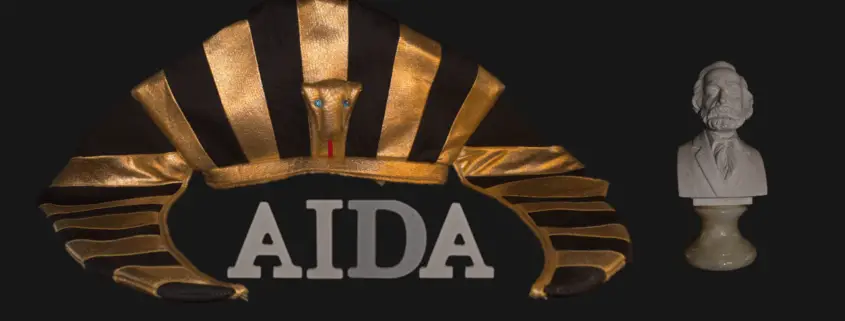The online opera guide of Verdi’s Aria O PATRIA MIA
Read Interesting facts and hear great YouTube Videos about the famous Aria “O patria mia” from Giuseppe Verdi
If you want to hear more about the opera Aida, click on the link to the opera portrait
The Aria – Synopsis and background
O Patria mia is a melancholic aria sung in the mood of a full moon night on the Nile. The beginning must be kept in a gloomy mood, for Aida fears never to see her fatherland again. She slowly awakes from this mood until “l’ultimo addio”. A nostalgic oboe Cantilena introduces the theme of her homeland. We hear a pianissimo passage until the sounds literally suffocate. Images of her homeland are evoked. Desperation manifests itself in the many repetitions of the “mai piu”. In “che un di promesso” the voice becomes more intense and the next O patria is accompanied by an intense orchestral sound. Finally, with “non ti vedro” the mood of the beginning is taken up again, this time with wonderful high notes and again accompanied by the oboe. And the aria ends with a delicate and beautiful high pianissimo C.
O patria mia – the text
Qui Radamès verrà!… Che vorrà dirmi?
Io tremo… Ah! se tu vieni
A recarmi, o crudel, l’ultimo addio,
Del Nilo i cupi vortici
Mi daran tomba… e pace forse, e oblio.O patria mia, mai più ti revedrò!
O cieli azzurri, o dolci aure native,
Dove sereno il nio mattin brillò,
O verdi colli, o profumate rive,
O patria mia, mai più ti revedrò!
O fresche valli, o queto asil beato,
Che un dì promesso dall’amor mi fu;
Or che d’amore il sogno è dileguato,
O patria mia, non ti vedrò mai più!
Oh my homeland, I shall never see you again!
Oh blue skies, oh soft native breezes,
where the light of my youth shone in tranquillity;
oh green hills, perfumed shores,
oh my homeland, I shall never see you again!Oh cool valleys, oh blessed, tranquil refuge
which once was promised me by love;
now that the dream of love has faded,
oh my homeland, I shall never see you again!
Written for a «dramatic soprano»
The role of Aida is written for a dramatic soprano. The dramatic soprano must have a strong, voluminous voice. The demand for vocal creativity is high, which is why these roles are usually entrusted to vocally mature and experienced singers. The role requires a high resilience and endurance of the singer.
Famous interpretations of O patria mia
Who was the best Aida?
This question has moved the minds for a long time. Was it the Callas, Leontyne Price or the Tebaldi?
The role of Aida is difficult to sing. Aida has a high stage presence with long performances, which requires a lot of stamina to cope with the many difficult parts, such as the exposed high C in the beautiful aria «O patria».
Who was the best Aida? In the 50s the opera was recorded three times magnificently with this three great sopranos. Many people vote for Leontyne Price, who was described by the well-known critic John Steane as «the best Verdi soprano of the century». Listen to the two rivals Callas and Price in «O patria mia» and form your own opinion.
Let’s start with Leontyne Price. Fischer describes her voice as follows: «As an actress on stage, Leontyne Price remained clichéd in gestures from old opera days. The thing she was great at was her phenomenal voice material and its artistic use. The often described guttural sound of afro american singers could not be found in her voice, but she possessed what the English language calls «smoky». She sang with two clearly separated voice colours: The extraordinarily lush middle range and the deep range, reminiscent of an alto, had that smoky character, the fluent high range sounded bright and clear, and remained unstrained to the highest regions.» (Fischer, Grosse Stimmen).
O patria mia (1) – Price
As a comparison we hear how Legge and Kesting describe the voice of Maria Callas: «Maria Callas possessed the sine qua non for a great career, namely the immediately recognizable timbre. The voice was voluminous and in the best years it had a range of almost three octaves, although the highest height was not always secured and the depth…did not have the power to hold notes. The sound quality was luxurious, the technical ability phenomenal. Callas actually had three voices, which she could colour at will: At first a high coloratura soprano, far-reaching and agile, bright and brilliant, but also, if she wanted, cloudy and opaque. Even with the most intricate fioritures she had no musical or technical problems to overcome. Her chromatic runs, especially down, glided smoothly along… The middle of the voice was dark and slightly shaded. It was her most expressive register in which she could exude the most fluid legato. Here she produces her own unique and highly personal sound, sometimes as if she were singing into a bottle».
O patria (2) – Callas
In 2017 Anna Netrebko made her debut in the role of Aida. The reviews from Salzburg and New York were excellent.
O patria (3) – Netrebko
Aficionados of older recordings are going to find a treat in the third recording with Giannina Arangi-Lombardi, a singer from the golden age. Listen how her voice glides to the high C (4:45), incomparable.
O patria mia (4) – Arangi-Lombardi
and another interpretation by Angela Gheorghiu
O patria mia (5) – Gheorghiu
Peter Lutz, opera-inside, the online opera guide to O PATRIA MIA from the opera Aida




Leave a Reply
Want to join the discussion?Feel free to contribute!